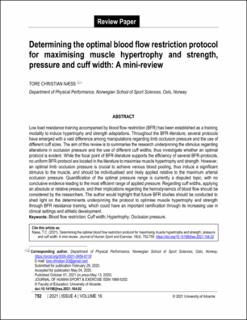| dc.contributor.author | Næss, Tore Christian | |
| dc.date.accessioned | 2022-03-21T15:57:11Z | |
| dc.date.available | 2022-03-21T15:57:11Z | |
| dc.date.created | 2021-10-07T09:13:16Z | |
| dc.date.issued | 2021 | |
| dc.identifier.citation | Journal of Human Sport and Exercise. 2021, 16(4), Side 752-759. | en_US |
| dc.identifier.issn | 1988-5202 | |
| dc.identifier.uri | https://hdl.handle.net/11250/2986624 | |
| dc.description | This work is licensed under a Attribution-NonCommercial-NoDerivatives 4.0 International (CC BY-NC-ND 4.0). | en_US |
| dc.description.abstract | Low load resistance training accompanied by blood flow restriction (BFR) has been established as a training modality to induce hypertrophy and strength adaptations. Throughout the BFR-literature, several protocols have emerged with a vast difference among manipulations regarding limb occlusion pressure and the use of different cuff sizes. The aim of this review is to summarise the research underpinning the stimulus regarding alterations in occlusion pressure and the use of different cuff widths, thus investigate whether an optimal protocol is evident. While the focal point of BFR-literature supports the efficiency of several BFR-protocols, no uniform BFR-protocol are located in the literature to maximise muscle hypertrophy and strength. However, an optimal limb occlusion pressure is crucial to achieve venous blood pooling, thus induce a significant stimulus to the muscle, and should be individualised and likely applied relative to the maximum arterial occlusion pressure. Quantification of the optimal pressure range is currently a disputed topic, with no conclusive evidence leading to the most efficient range of applied pressure. Regarding cuff widths, applying an absolute or relative pressure, and their implications regarding the hemodynamics of blood flow should be considered by the researchers. The author would highlight that future BFR studies should be conducted to shed light on the determinants underpinning the protocol to optimise muscle hypertrophy and strength through BFR resistance training, which could have an important ramification through its increasing use in clinical settings and athletic development. | en_US |
| dc.language.iso | eng | en_US |
| dc.subject | blood flow restriction | en_US |
| dc.subject | cuff width | en_US |
| dc.subject | hypertrophy | en_US |
| dc.subject | occlusion pressure | en_US |
| dc.title | Determining the optimal blood flow restriction protocol for maximising muscle hypertrophy and strength, pressure and cuff width: A mini-review | en_US |
| dc.type | Peer reviewed | en_US |
| dc.type | Journal article | en_US |
| dc.description.version | publishedVersion | en_US |
| dc.rights.holder | © 2021 University of Alicante | en_US |
| dc.source.pagenumber | 752-759 | en_US |
| dc.source.volume | 16 | en_US |
| dc.source.journal | Journal of Human Sport and Exercise | en_US |
| dc.source.issue | 4 | en_US |
| dc.identifier.doi | 10.14198/jhse.2021.164.02 | |
| dc.identifier.cristin | 1944032 | |
| dc.description.localcode | Institutt for fysisk prestasjonsevne / Department of Physical Performance | en_US |
| cristin.ispublished | true | |
| cristin.fulltext | original | |
| cristin.qualitycode | 1 | |
